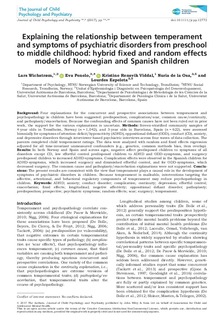Explaining the relationship between temperament and symptoms of psychiatric disorders from preschool to middle childhood: hybrid fixed and random effects models of Norwegian and Spanish children
| dc.contributor.author | Wichstrøm, Lars | |
| dc.contributor.author | Penelo, Eva | |
| dc.contributor.author | Viddal, Kristine Rensvik | |
| dc.contributor.author | de la Osa, Nuria | |
| dc.contributor.author | Ezpeleta, Lourdes | |
| dc.date.accessioned | 2017-12-28T14:03:23Z | |
| dc.date.available | 2017-12-28T14:03:23Z | |
| dc.date.created | 2017-09-27T15:41:51Z | |
| dc.date.issued | 2017 | |
| dc.identifier.citation | Journal of Child Psychology and Psychiatry. 2017. | nb_NO |
| dc.identifier.issn | 0021-9630 | |
| dc.identifier.uri | http://hdl.handle.net/11250/2473831 | |
| dc.description.abstract | Background Four explanations for the concurrent and prospective associations between temperament and psychopathology in children have been suggested: predisposition, complication/scar, common cause/continuity, and pathoplasty/exacerbation. Because the confounding effects of common causes have not been ruled out in prior work, the support for the various explanations is uncertain. Methods Screen-stratified community samples of 4-year olds in Trondheim, Norway (n = 1,042), and 3-year olds in Barcelona, Spain (n = 622), were assessed biennially for symptoms of attention-deficit/hyperactivity (ADHD), oppositional defiant (ODD), conduct (CD), anxiety, and depressive disorders through interviewer-based psychiatric interviews across four waves of data collection. The parents completed child temperament ratings. The data were analyzed with random and fixed effects regression adjusted for all time-invariant unmeasured confounders (e.g., genetics, common methods bias, item overlap). Results In both Norway and Spain and across ages, negative affect predisposed children to symptoms of all disorders except CD, low effortful control predisposed children to ADHD and ODD-symptoms, and surgency predisposed children to increased ADHD-symptoms. Complication effects were observed in the Spanish children for ADHD-symptoms, which increased surgency and diminished effortful control, and for ODD-symptoms, which decreased surgency. The common cause and pathoplasty/exacerbation explanations were not supported. Conclusions The present results are consistent with the view that temperament plays a causal role in the development of symptoms of psychiatric disorders in children. Because temperament is malleable, interventions targeting the affective, attentional, and behavioral regulatory components of temperament may reduce psychopathology in children. | nb_NO |
| dc.language.iso | eng | nb_NO |
| dc.publisher | Wiley | nb_NO |
| dc.rights | Navngivelse-Ikkekommersiell 4.0 Internasjonal | * |
| dc.rights.uri | http://creativecommons.org/licenses/by-nc/4.0/deed.no | * |
| dc.title | Explaining the relationship between temperament and symptoms of psychiatric disorders from preschool to middle childhood: hybrid fixed and random effects models of Norwegian and Spanish children | nb_NO |
| dc.type | Journal article | nb_NO |
| dc.type | Peer reviewed | nb_NO |
| dc.description.version | publishedVersion | nb_NO |
| dc.source.journal | Journal of Child Psychology and Psychiatry | nb_NO |
| dc.identifier.doi | 10.1111/jcpp.12772 | |
| dc.identifier.cristin | 1499062 | |
| dc.relation.project | Norges forskningsråd: 228685 | nb_NO |
| dc.relation.project | Norges forskningsråd: 190622 | nb_NO |
| dc.description.localcode | © 2017 The Authors. Journal of Child Psychology and Psychiatry published by John Wiley & Sons Ltd on behalf of Association for Child and Adolescent Mental Health. This is an open access article under the terms of the Creative Commons Attribution-NonCommercial License, which permits use, distribution and reproduction in any medium, provided the original work is properly cited and is not used for commercial purposes. | nb_NO |
| cristin.unitcode | 194,67,40,0 | |
| cristin.unitname | Institutt for psykologi | |
| cristin.ispublished | true | |
| cristin.fulltext | original | |
| cristin.qualitycode | 2 |
Tilhørende fil(er)
Denne innførselen finnes i følgende samling(er)
-
Institutt for psykologi [3123]
-
Publikasjoner fra CRIStin - NTNU [38484]

